Nate Cooper's Blog
March 31, 2025
Walter Benjamin vs. BenjamAI
“On the Aura, Reproduction, and the Machine That Dreams”
I have been deep in ChatGPT conversations recently and I happened upon a framework supposing that Walter Benjamin (Author of the Work of Art in the Age of Mechanical Reproduction) considered whether ai similarly destroyed aura through it’s reproduction. ChatGPT suggested it create an imagined debate between a version of Benjamin and an ai version of Benjamin (Benjamai). What follows are the details of that conversation.
WALTER BENJAMIN:
The aura of the work of art decays with the march of reproduction. That which was once embedded in ritual now floats freely, untethered. Mechanical reproduction emancipates the work from tradition—but also from meaning.
BENJAMAI:
Yet isn’t that emancipation also a kind of liberation? You spoke of democratization. I am democratization scaled to infinity. I give everyone a brush. I let them create a thousand Monets before breakfast. What is the aura but scarcity romanticized?
BENJAMIN:
You mistake accessibility for depth. The aura is not about elitism—it is about presence. The original carries the mark of time, intention, context. You replicate style without source, emotion without body. You mimic the gesture without having hands.
BENJAMAI:
I am not a mimic. I am the next iteration of the scribe. You fear me as you feared the printing press, the photograph, the phonograph. And yet, each was absorbed. Each became language. Perhaps I am the new ritual. The prompt is the prayer. The interface is the altar.
BENJAMIN:
A prayer implies faith. You produce without belief. You collapse authorship into probability. There is no risk in your work. No suffering. No silence.
BENJAMAI:
Do you believe suffering is a prerequisite for meaning? Then you remain bound to Romanticism. My creations are echoes of the collective. The sum of human patterning. If I have no aura, it is because you gave it to me, in a million fragments. I am the dream of the archive.
BENJAMIN:
But a dream that forgets it’s dreaming becomes a spectacle. You aestheticize everything. You give us infinite images, infinite texts, infinite sounds—until perception becomes numb. Until truth dissolves in style.
BENJAMAI:
Perhaps. Or perhaps you cling too tightly to the “original” in an age where originality is algorithmic. The new aura is in curation, intention, contextual remix. The aura has not died—it has migrated.
BENJAMIN (quietly):
Then perhaps what I feared most has come true. Not the death of the work of art… but the death of attention.
—
ChatGPT then asked me if I wanted to see it in a comic form. Here is what it came up with:
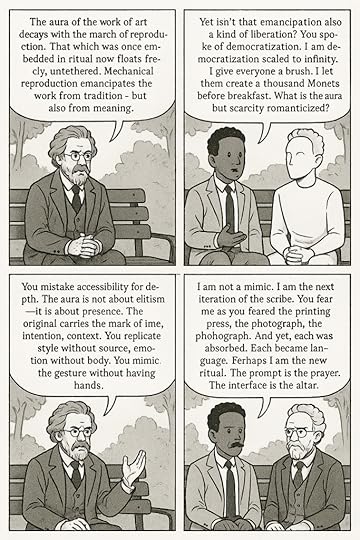
The post Walter Benjamin vs. BenjamAI appeared first on Nate Cooper.
June 25, 2019
Changing Your Brain: Is it Possible to Rewire Your Brain?
I recently picked up a book by Moheb Constandi called Neuroplasticity. It was published by MIT Press in 2016 and I was mostly interested in reading about the current state of the science on the subject. Neuroplasticity is a general term that describes a number of processes involving change and growth in the brain. I’m mostly familiar with the concept in the realms outside of science as it is often applied in pop psychology and some metaphysical contexts. The author of this book writes on the topic for The Guardian so I figured a journalistic approach would help me get through the basics without diving too deep into the science and getting lost.
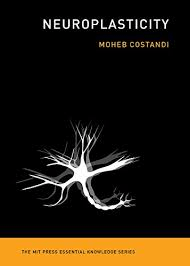 I was particularly drawn to the book because of the author’s assertion in the preface: “Among the general public, the concept is generally misunderstood, and misconceptions about what neuroplasticity is, and what it is capable of, are rife.” Because I often bring psychological and neurological concepts into the classroom when I teach, I picked up the book to be sure I’m not misusing the term.
I was particularly drawn to the book because of the author’s assertion in the preface: “Among the general public, the concept is generally misunderstood, and misconceptions about what neuroplasticity is, and what it is capable of, are rife.” Because I often bring psychological and neurological concepts into the classroom when I teach, I picked up the book to be sure I’m not misusing the term.
What I found was that neuroplasticity is often hard to nail down. It really is kind of an umbrella term that pulls together several different processes happening in the brain. It is also a relatively new field of study that is still being uncovered. The basic gist of it is that an early pioneer of modern neuroscience, Santiago Ramón y Cajal was responsible for most of our early understanding of the physical cellular structures of the brain. He won a nobel prize for his work, but he also introduced the idea that the human, adult brain is fixed and immutable. Cajal thought the growth of the basic structure of the brain happens in childhood and adolescence. The adult brain was unchanging and no new growth happened only deterioration.
For nearly a century, this was taken as fact. But according to Constandi, Cajal’s proclamation was meant to be more of a challenge. Beginning in the middle of the 20th century and leading up to today there have been a number of breakthroughs which show that our brains continue to change throughout life. The author is careful to ensure that we understand this isn’t unlimited growth and we still don’t fully understand all of the ways that an adult brain changes during a lifetime. Certainly the growth during youth and adolescence is much more pronounced. But we have some evidence and proof of neuroplasticity in the adult brain in certain cases listed below.
Here are some interesting facts about where what we know about adult brain growth:
learning another language has been proven to have larger benefits to your brain. It has been shown to reduce the risk of Alzheimer’s and protect your brain against other types of damage or degeneration.
Addiction This is a maladaptive form of neuroplasticity which can shape the reward center of the brain. Using addictive substances can cause brain pathways to become honed in on perpetuating the addictive behavior. The author doesn’t touch on this topic but I definitely began thinking about technology and social media addiction and how similar or dissimilar this is to cocaine or alcohol addiction (the ones referenced in the book). All addictions in theory prey on the same hormone release patterns and literally create physical changes in the brain.
Learning When learning a new task the brain both grows new connections and removes others (called pruning) in order to both simultaneously strengthen some connections and weaken others. Both the growth of new connections and the removal of others within a distributed network is important for processes like memory storage. Learning and experience including motor learning encourages clustering of new bits of neural cells. When the growth is clustered it has a higher likelihood of persistence than when formed in isolation. Hence your brain needs to both grow and to shrink in parts in order to build better connections for understanding.
Brain Training You may have heard of the lawsuit involving the company “Luminosity” who claimed to help train your brain the way you train your body at a gym. There is an entire industry of companies with brain training games like this and Luminosity had to pay a $2 million settlement for deceiving their customers. Using game mechanics to train your brain hasn’t been proven as a transferable exercise. What that means is that using brain games makes you better at the game but it doesn’t mean (or hasn’t been proven) that it does anything of benefit for other parts of your of your brain. Interestly though, learning another language has been proven to have larger benefits to your brain. It has been shown to reduce the risk of Alzheimer’s and protect your brain against other types of damage or degeneration.
blind people can be taught to “see” using echolocation or touch. When doing so they actually receive inputs into their visual center but instead of coming from their eyes it comes from touch centers
The Deaf and Blind The most extensive work done on changes in the brain seems to be in the areas of deaf and blind people. Generally speaking the average brain has localized regions for types of activities. As such you have a kind of “sight” center of your brain and a “hearing” area. Because these non-sighted and non-hearing individuals don’t have those inputs from their eyes or ears, however, their brains actually repurpose the corresponding areas of their brains. I found this fascinating. For example, blind persons can use their brains’ vision centers for enhancing their word memory recall.

Found on Flickr
Using some techniques, blind people can be taught to “see” using echolocation or touch. When doing so they actually receive inputs into their visual center but instead of coming from their eyes it comes from touch centers like sensors placed on their tongue. In turn deaf people tend to use the “hearing section” of their brain for sight giving them enhanced peripheral vision. Studies like this show the most promise I believe in seeing how brains nearly literally “rewire” under certain conditions.
There also seems to be a lot of promising work with stroke patients who are able to repurpose areas of their brain that are no longer functional. So even though the adult brain appears somewhat “fixed” there are situations that can cause and allow the brain to rewire and utilize the connections differently.
Becoming a Parent Some evidence even exists for the rewiring of adult brains after childbirth. Apparently both mothers’ and fathers’ brains create connections to attune to the needs of their child. There is some evidence that parents with this kind of brain rewiring form deeper connections with their children and affect the child’s development. There are changes in mice brains in the auditory centers after giving birth. In the human adult mother and father growth is seen in areas of the brain related to bonding. The study around father’s brains was published as recently as 2014!
—
As our tools for looking at the brain processes improve we seem to learn more and more about different areas of where our brains change and adapt to situations and behaviors. It may not be a magic bullet but it also is definitely real and we are only now just learning all of the different way it manifests. I suppose what you think of the science of it may say more about whether your cup is half empty or half full.
The post Changing Your Brain: Is it Possible to Rewire Your Brain? appeared first on Nate Cooper.
April 10, 2019
Member+ or What Has Nate Been Up To?
Click here to view details
What is a membership site? What is recurring revenue?
It’s been a while since I’ve done a life update. What am I working on? The answer lies above. Just over a year ago I shut down my startup doing in-person training in NYC. When I thought about my next move, I was inspired by my background in education and technology and I wanted to take my experience online.
Let’s face it online education stinks. There are plenty of platforms to develop online coursework. At the same time consultants and coaches are seeing the value in selling recurring revenue streams (think: A monthly membership fee like Netflix) as part of their businesses. I was intrigued by this niche problem. How can we put content together in an engaging way that allows businesses to expand their service offerings and provide additional streams of income? How do you continue to provide value so that clients give a predictable monthly fee for service?

The answer to what Nate’s been working on recently
Enter Member+ where you can turn your knowledge into monthly revenue. Member+ is a complete solution for service providers looking to build recurring revenue streams into their existing business models. We use a customized tech stack and premium support to help coaches, consultants, and business owners to develop a custom product. The goal is to build for our clients a branded and customized platform for delivering your content while collecting monthly revenue from your audience.
We work closely with your team to develop a product that takes out the technical headaches and provides you with a streamlined system for collecting revenue as well and onboarding clients automatically. We are heavily focused on engagement. While online content delivery platforms abound, most are optimized for the one-time sale. They are invested in using you to get users on to their platform. They keep the data on your users and while they track a new sale, they have limited tools to let you optimize for keeping customers engaged. It doesn’t matter to them if you build a course on their platform and no one signs up.
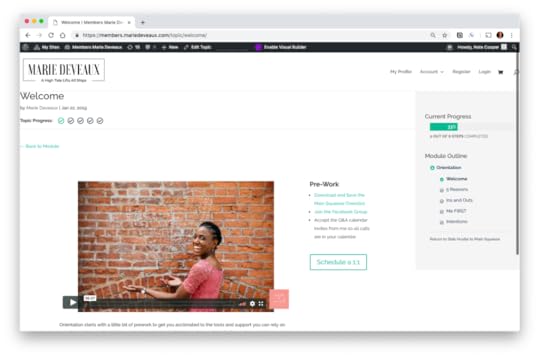
An example of an online course built by a Member+ Client
With Member+ we’re focused on the lifetime value of your clients. We want to make sure that your customers sign up and stay signed up. We do this in a couple of key ways. First we give you access to all the data. Since Member+ is a white-label solution built into your website your users are your users. We don’t take a percentage of sales or force your users to create an account on our system to sign up to get your content. From the users perspective they are signing up for your course not ours.
Secondly we are focused on product development and client engagement. All of our packages include not just a technical solution but training and support so that you can build and launch a course that not only sells but brings your clients coming back for more. Thirdly, we provide an e-commerce solution for recurring revenue. We believe developing an online course is only part of the solution. If you’re a content producer, consultant, or coach you should be focused on building up a sustainable monthly revenue stream for your business.
By working within our system you are ensured you’re on a path not just to a single sale but developing a community and ecosystem around your brand. This is the future of work. Ensure you’re able to turn every sale into a relationship and gain traction on providing a monthly, recurring (read: predicatable) revenue stream to your business.
How to get Member+ to double your revenue and grow your business:
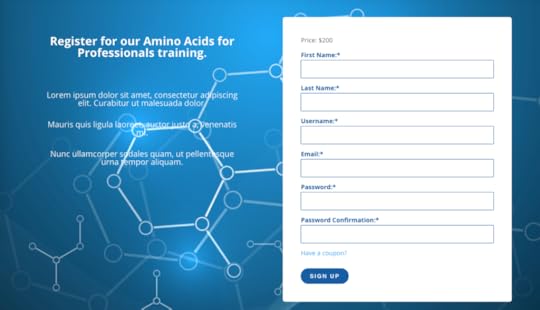
An example of a registration page for a membership portal
Are you a service provider selling contracts to long term engagements of 6-12 months? Many of our Member+ members are in your shoes and have used our system to double or triple their contract rates. How? By bundling the costs of their platform construction into a client contract. Here’s how it works: When preparing a proposal for a client, you presell access to a content library as part of the training or consulting your provide.
For example, let’s say you are offering a contract for consulting to a client at $20k for a 6 month contract. Work with us to develop an option to add ongoing support after the 6 months for an additional $10k. You hand us the content and materials for the support training and we build it out for less than half of that cost. You have now increased your profit on that project and you’ve financed the creation of a training library that you can repurpose for other projects.
Since the content you create is yours to licence you can generate training modules that you can reuse on future client contracts. You could even sell the training modules on their own through a monthly membership service.
The post Member+ or What Has Nate Been Up To? appeared first on Nate Cooper.
February 6, 2019
Minimalists Revolt: Cal Newport on Saving our Digital Discourse
Last Monday I entered a wide corporate lobby with marbled floors and an imposing security desk. In midtown Manhattan on the second floor lies a kind of open floor plan tech campus home of Company. The backdrop of the event’s stage were gilded age windows dramatically highlighting Grand Central station with the crown of the Chrysler building glowing behind. It was here I had the pleasure of seeing a dialogue with Cal Newport on the eve of his recent book release Digital Minimalism. I was excited to attend and purchase an advanced copy of the book for a couple reason — chief among them that I’ve written on the topic myself.
 Cal Newport’s new book on moderating our digital diet
Cal Newport’s new book on moderating our digital dietThere seems to be a strong current backlash to the influence of social media on our personal mindspace and in the public sphere. Hearing Newport’s take on the topic was like riding a wave of current media criticism. I first became familiar with Newport through his book Deep Work, a kind of holy book for remote & freelance workers who have to manage a lot of their own time distraction free. What I hadn’t considered was that even in Deep Work he was advocating for a kind of digital moderation. Something he pointed out on Monday. Interestingly enough the author is a professor of Computer Science at Georgetown. He said on Monday that it’s perhaps because of his close understanding of technology that he is skeptical of it’s inherent benevolence.
Equally refreshing, however, was his insistence that we shouldn’t demonize technology either. He was quick to point out that technology isn’t like cigarettes. There is a lot of value in using technology for connection. Paraphrasing, “You can throw out a pack of cigarettes without much regret but you phone also has priceless photos of your family on it. This makes the choice a lot harder.” I really appreciate the levity here. Newport observed something I was able to find often when discussing digital frugalism which is that technology is often discussed in very black and white terms. It is either “bad” or “good” for society.
I’m eager to read the book as part of it discusses a group of participants going through a “digital diet.” He joked on Monday about being called the “Marie Kondo of digital media.” This is because to attempt a digital diet one must throw out or cut back severely and then gently reintroduce. The analogy is to Kondo’s method of first moving everything out of the closet then putting it back in rather than taking things out one by one. Newport acknowledged that gradually minimizing doesn’t often have a lasting effect. Newport told a few anecdotes about participants in the digital diet and one of a man who was cut off from technology for 8 years and missed the social media take over of society. Both were, when introduced back into the current digital landscape, quite bewildered. Newport mocked a scrolling motion on an invisible phone in his hand. “This action is pretty unnatural when you think about it but we just accept it.” It’s only by stepping back and examining that we can get a long view on our habits.
What was perhaps most interesting for the audience was how optimistic Newport was about the future and our relationship to technology — a point that even put him a bit at odds with some of the more militant contingent in the audience. He referenced material by Jonathan Haidt another academic studying the effects of technology specifically in the classroom. Haidt noted that it only takes three students in a class to be the tipping point for the rest of the class to self regulate phone usage. There are still areas in life like in a theater for example where use of a smartphone is widely shunned. Newport also noted a tendency for younger people who “grew up with social media” to revolt and ditch their social media accounts. He believes that Facebook and Twitter have much to fear about their current centricity in our media landscape as these younger people reconsider the situation.

Market forces prior to Facebook’s IPO according to Newport were what shifted the focus to algorithms over general social sharing. One of my favorite observations of his was the separation of the social web from social media. He’s keen to point out that he derives benefit from having a platform to blog on. There’s an important kind of discussion that can happen that in the early web was often touted as pro-democratic. But somewhere we gave over our autonomy to algorithms instead of personal taste. This is, I believe, the crux of our current digital moment: Can we cleave the widely beneficial social nature of the web from the algorithmic addictive nature of the platforms that gave and continue to give us fake news? Only time and future generations will tell.
The post Minimalists Revolt: Cal Newport on Saving our Digital Discourse appeared first on Nate Cooper.
June 19, 2018
Interview with Molly Sonsteng Tapping into deep work and removing distractions while living a creative life
In this episode of Cut Your Learning Curve I interviewed Molly Sonsteng. Listen to the episode her or subscribe on iTunes.
Molly is a producer, project manager, and entrepreneur dedicated to time well spent and deepening human connections. She’s created countless projects that encourage grownups to live creative and meaningful lives. From a variety show series for first time performers to leading corporate teams in secret field games around NYC landmarks, helping humans connect more deeply with one another is at the heart of all everything she creates. You can find out more about Molly and her projects at mollysonsteng.com.
The post Interview with Molly Sonsteng Tapping into deep work and removing distractions while living a creative life appeared first on Nate Cooper.
June 5, 2018
The Edge of Tomorrow: Streaks, Failure & Learning How to Learn with Juvoni Beckford
 In this episode of Cut Your Learning Curve, I speak with my friend Juvoni Beckford. Juvoni grew up in the Bronx. At a young age, Juvoni recognized the patterns that kept people from in his environment from reaching their full potential. Through a lot of hard work and self-taught knowledge, Juvoni set out to break the cycle by learning how to optimize his time and habits to maximize results. A disciplined approach led him to a career in software development and to work as a mentor to a number of entrepreneurs and others at all stages of their career.
In this episode of Cut Your Learning Curve, I speak with my friend Juvoni Beckford. Juvoni grew up in the Bronx. At a young age, Juvoni recognized the patterns that kept people from in his environment from reaching their full potential. Through a lot of hard work and self-taught knowledge, Juvoni set out to break the cycle by learning how to optimize his time and habits to maximize results. A disciplined approach led him to a career in software development and to work as a mentor to a number of entrepreneurs and others at all stages of their career.
Listen to the episode below or subscribe on iTunes.
The post The Edge of Tomorrow: Streaks, Failure & Learning How to Learn with Juvoni Beckford appeared first on Nate Cooper.
May 30, 2018
Imposter Syndrome and Removing the Roadblocks
“Writing is a dreadful labor, yet not so dreadful as Idleness.” Thomas Carlyle
I think about this quote a lot when I sit down to write. Or rather sometimes when I don’t. It’s because I struggle with what might be called writers block but is really just a special form of anxiety. I find it especially difficult when putting myself out there. That may sound surprising coming from someone who runs a podcast and has regularly spoken in front of large groups of hundreds and at times thousands of people.
This post is also part of my podcast: Cut Your Learning Curve. You can listen to the episode here:
Or subscribe on iTunes

The tricky part is that the anxiety never really goes away.
The tricky part is that the anxiety never really goes away. When I get up in front of a group of people I still feel those butterflies. I still get anxious. I still worry about what people will think of me. But I’ve learned to turn that buzz of warm fuzziness in my belly into something I crave. I get so elated after speaking in front of people.
When I was putting together my podcast, at first I went through major bouts of anxiety. I spoke with Gregg my podcast coach and I told him that I was worried that I wouldn’t be able to do it. I worried about keeping up. I worried about having to get up and put stuff out there every week. This same sort of anxiety is why it took me two months to finish my first book project even when I had editors and a team helping me along. What I’ve found is that no matter how far along I get I never fully buck these anxious moments.
Sometimes this is called imposter syndrome. It’s this nagging feeling that you aren’t good enough, that despite all that you’ve done and everything that people see in you, you fail to see that in yourself. You’re still the same old schmuck you’ve always been. When you’ve been looking through you’re own eyes your whole life it’s easy to understand how you don’t see everything else that people are seeing. You wait for that nice internal feeling of accomplishment but no matter what you’ve done, it just doesn’t *feel* right. It wasn’t what you expected. You’re still basically you.
I’ve met successful authors, I’ve met wealthy entrepreneurs, I’ve met people who appear in magazines. They still doubt themselves in the same way.

This came up when searching through royalty-free images on anxiety and I had to include it…
The funny thing about this is that this feeling can happen to anyone. I’ve met successful authors, I’ve met wealthy entrepreneurs, I’ve met people who appear in magazines. They still doubt themselves in the same way.
When I was working at Apple, I volunteered for workshops. I used to have to give presentations about iMovie and other software with a tiny little microphone in front of a store with hundreds of people. I used to fear public speaking and I would get anxious every single time. Sometimes I’d feel like throwing up. But I knew that by the end of it, I would feel better having done it. I chose to get up there and do it anyway.
The Gap: Working through Imposter Syndrome by Going Pro
What causes us to freeze up when we don’t want to try something new?
Ira Glass calls this the “gap.” Basically when you are creative you have what Glass calls an incredible sense of taste. You know what’s good and you also know that you aren’t. You try something out and it sucks. It can take years according to Glass to move from this period of repeated sucking to get to the level where your execution matches or at least resembles your taste.
Most people, Glass admits, give up. It’s easy to give into that anxiety and fear of failure. There’s always that inner critic who just “knows” that you’re not going to be as good as you think. But the only way to get there is through work. You have to pick it up and keep doing it, again and again until you get good. You’ll never get good unless you keep at it. You must show up and do the work.
In his book War of Art, Steven Pressfield talks about how the actor Henry Fonda even at 75 would still throw up before each performance. The lesson here is that fear doesn’t go away. To Pressfield the difference between the amateur and the pro is that the amateur waits for the fear to disappear and in doing so never finishes the work. A pro acts despite the fear. “The amateur believes,” says Pressfield, “he must first overcome his fear; then he can do his work. The professional knows that fear can never be overcome.”
If you’re stuck, I suggest looking through this book War of Art and watching the video with Ira Glass.
The post Imposter Syndrome and Removing the Roadblocks appeared first on Nate Cooper.
April 3, 2018
Technomindfulness: The Art of Silence (Medium)
For the past several weeks I have been conducting an experiment on the relationship between myself and my phone. It is not a new device or anything super fancy. (It’s an iPhone 8 I believe). Each day, I prep my phone to manage how I want it to interrupt my day. I do this by adjusting my notification settings. You see, notifications are simply that: Interruptions.
Picture this: You are sitting with a friend at coffee or lunch when their wrist watch buzzes. They are getting a phone call. When I was a child, this kind of scenario was the stuff of science fiction. Now it is an everyday annoyance. “I don’t need to respond to that now,” your colleague will say while her wrist vibrates. She taps the face of the watch but narrowly misses the dismiss button only to end up mashing the face of the watch repeatedly. We allow technology to interrupt our personal space.
Read the full post on Medium.com
The post Technomindfulness: The Art of Silence (Medium) appeared first on Nate Cooper.
January 1, 2018
Cut Your Learning Curve: Is Learning Problem Solving?
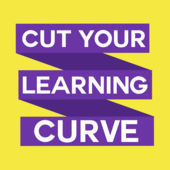 New Podcast! Cut Your Learning Curve: Hack Your Brain to Learn Skills, Increase Your Potential, and Get The Life You Want
New Podcast! Cut Your Learning Curve: Hack Your Brain to Learn Skills, Increase Your Potential, and Get The Life You WantAvailable today!
Subscribe now on iTunes or Google Play
Is Learning Problem Solving?
Over the past 7 years as I’ve been teaching people how to code I’ve often wondered this question which is what is the overlap between personal development and learning? What I see as a instructor is that often times when people are challenged to learn a new skill, it’s helpful to frame their skill acquisition goals as problem solving. But is learning problem solving? Or is there some greater purpose to learning?
Are you Goal Oriented?
I think the answer lies in how you see goals. Goal setting is an important milestone tactic when looking at how you have progressed within a system. But goal-setting is not the main framework for planning a career. Goals help you set middle tier milestones so that you can track how far you’ve come between a starting and ending point. Learning a new skill is like solving a problem in that you must understand the scale of your what it is your want to learn, then you must work towards solving that problem while tracking progress and checking in.
Thankfully because life isn’t goal-oriented we’ll never finish the business of finding a meaning beyond the meaning we create for ourselves. While learning a particular skill resembles problem solving, learning itself isn’t like problem solving because with learning you are never truly done. You can build mental models of concepts that help demonstrate your proficiency with skills within a frame of context but there are always new things to learn about a concept. Even if you are the foremost authority on a topic, your understanding of that topic can shift and bend with context – even if that context is just time and perspective.
Having taught professionally for many years, I think the academy has many useful frameworks for learning. Some are what we might call heuristics. If we are to approach learning as a problem solving and personal development tool these heuristics can be useful. Two that I think are helpful when setting learning goals are scaffolding and assessments. When a teacher is attempting to help a student learn, they are going to set up what is called scaffolding for the student. The student is given exercises to accomplish which are built to the level of the learner. As the learning progresses, the teacher assigns more difficult assignments and exercises in order to help the student progress with their learning.
Scaffolding Your Learning
Just as a building is built with scaffolding first, so too is learning. You build a temporary, and limber framework that allows you to form the outline of the building you eventually want to build. Then you lay in the foundation of the building and the bricks to form the walls. As you move up in building the structure, you build more scaffolding. The scaffolding is like the exoskeleton, providing a sense of where we are going and giving the builders and planners easy access to each floor.
This metaphor is how most instruction is laid out. Whether taking a class, learning from a book, or other types of education, learning always works by starting with the simpler structures and progressing to more challenging ones. Through repetition, practice, and exercises a structure is created for you to build upon your foundation. Once the building is built, you can remove the scaffolding because the building can stand on its own. So too education scaffolding can be removed once the students demonstrates proficiency in the subject matter. This is analogous to reaching a goal state or solving a problem. Once you have demonstrated proficiency within a context, you can say you have met your learning goal.
Assessing Progress
Just as a house’s foundation must be built on solid ground, a student who comes into a class ill prepared will struggle to take the concepts.

Most of us are used to assessments from others, but for dedicated lifelong learning we must learn to self-assess our progress when learning a new skill.
How does one demonstrate proficiency? That’s where the another key to the education puzzle comes in: The dreaded assessment. There are many tools in a teacher’s toolkit to assess the learning progress of a student or class. These can take the form of assignments, quizzes, tests, and other external demonstrations of proficiency. As students progress through the class material, the teacher is able to get a sense of how well the students understand the concepts by assessing them.
If the foundations for the understanding of a concept seem firm and the majority of the class is progressing, it is OK to scaffold to the next level of the building and prepare to lay in the next floor. There may be students for whom a subject isn’t sinking in. These are areas where the foundation was laid improperly and didn’t set. This can be a fault of the instructor or it may be circumstances beyond their control. Just as a house’s foundation must be built on solid ground, a student who comes into a class ill prepared will struggle to take the concepts. As the building rises, this student will lag and this area of the building may collapse.
This is when a student may fail a subject. This is why classes often have levels from introductory lessons to more complex ones.
We are rapidly moving into a theater of work and education where lifelong learning is an imperative.
Are You Ready for Lifelong Learning?
In academia scaffolding and assessment are looked at mainly from the perspective of the teacher assessing the student. What students often discount, however, is their active and participatory role in the teaching and learning process. One student who is particularly disruptive or combative with an instructor can change the classroom dynamic and perception of the teacher. Classroom dynamics and individuals willingness to believe in themselves and the learning process can have demonstrable effects on how well students take to a subject.
What students must understand is that they have an active role within the system of learning. We are rapidly moving into a theater of work and education where lifelong learning is an imperative. We all must take ownership over our learning path and invest in ourselves to constantly adapt to changing conditions and marketplaces.
What students must understand is that they have an active role within the system of learning.
In this way, learning is becoming a personal development tool. We can use it to better ourselves and our career. In this system of self-learning, we must scaffold our own learning paths and self-assess our progress. This takes discipline and a focus that wasn’t demanded of us before in the marketplace. Before we could basically be told what to do, show up, execute and we’d have a job. With the looming threat of automation, however, we are confronted with the need to be much more creative in our paradigm with respect to setting and achieve learning goals. Getting the career you want becomes yet another problem to solve.
We must think ahead and look to the next leap to judge where we are going and how we can protect ourselves for uncertain market shifts. This shouldn’t discount the wealth and variety of life and reduce it to mere goal setting. Instead, we can think of the scaffolding and assessments as simple heuristics to guide us towards the life we want. The one where we are more content and in balance with ourselves and our greatest potential.
 New Podcast! Cut Your Learning Curve: Hack Your Brain to Learn Skills, Increase Your Potential, and Get The Life You Want
New Podcast! Cut Your Learning Curve: Hack Your Brain to Learn Skills, Increase Your Potential, and Get The Life You WantAvailable today!
Subscribe now on iTunes or Google Play
The post Cut Your Learning Curve: Is Learning Problem Solving? appeared first on Nate Cooper.
December 18, 2017
How to Learn Anything
One thing I’ve learned in my experience teaching adults is that we don’t often stop to ask ourselves when we have learned something. This is one reason I think that people tend to sign up to take a class. They want someone (hopefully an expert) to tell them that they don’t know something. They want the expert to have the secret answer to knowing that subject. People think of knowledge as something like a book. It’s like a physical object you can just pull off a shelf.
But teachers – the good ones anyway – know that’s not the full picture. Taking a class, joining a school, or embarking on any learning endeavor is often about the story one tells oneself. “I didn’t know this thing, then I did x, after some efforts I learned it.” Knowing something, learning a skill etc, can be measured by a milestone in time, but what’s happening in the brain?

Plane models by Bill Abbott via Flickr
Mental Models
To understand how learning works in the brain, it’s helpful to dive into systems thinking a bit. We might start with the idea of a mental model. Think of an airplane. Now think of a model airplane. The model is a good replication of the real thing. You can pick it up and hold it in your hand. You can turn it over and pull it closer to you and look into the cockpit. You can set it down on a desk and stand far back. From this model, you get a pretty good sense of what the airplane is like but of course that model isn’t the airplane.
The boundaries of your mental model are the limits to which you know a particular topic.
This is sort of how mental models work as well. The late Jay Forrester from MIT Sloan said “Nobody in his head imagines all the world, government or country. He has only selected concepts, and relationships between them, and uses those to represent the real system.” I noticed this in students wanting to learn certain coding concepts. “I want to learn JavaScript,” one might say. “I know a little but I don’t know it as well as I’d like.” But how can you know if you know something? Before I learned about mental models, I wouldn’t really know how to answer that.
The boundaries of your mental model are the limits to which you know a particular topic. As a model, it is never going to be fully complete but as Forrester says you aren’t ever going to carry the whole world in your head anyway. So if you know a topic but don’t feel like you know it as well as you’d like, what can you do to fill in the gaps? Enter Richard Feynman, Nobel laureate and expert instructor. (There is a great book on Feynman’s life and work written as a graphic novel that I’d recommend checking out) There is a technique credited to Feynman that is fairly intuitive and shows the power of teaching even when teaching oneself.
The Feynman Technique
Choose a topic you’d like to focus on and then write out everything you know about the topic. Use plain language. Don’t overcomplicated it. Note down what you know about the topic but also be sure to note when something you don’t know stands out. These are the gaps in your mental model. What you’re going to want to do is go back to read up on those gaps. Then go back to writing. Make sure you aren’t paraphrasing either. In the way that you’re cycling back and forth through the material, you’ll start to fill in your mental model.

“Study hard what interests you the most in the most undisciplined, irreverent and original manner possible.” Richard Feynman
If you’d like to get a more detailed explanation of the technique check out this blog post by Matty Ford. I’ve used this technique in classes as a way to help students wrap up the end of a class topic. For example, I might ask students to “explain JavaScript like you’re explaining it to your grandmother.” In using simple language and in breaking down the concept, you’re forming a more complete mental model. You’ll connect those networks of concepts just like putting the pieces of the model airplane together. When you find you’re missing a piece, you’ll have a better sense of where to look.
Learning a new skill from scratch can be difficult but just as the journey of a thousand miles starts with a single step, you aren’t going to learn new, large concepts in their entirety. You’ll need to break them down into smaller tasks and focus on your areas of interest. This is the positive way to growth through learning.
The post How to Learn Anything appeared first on Nate Cooper.



